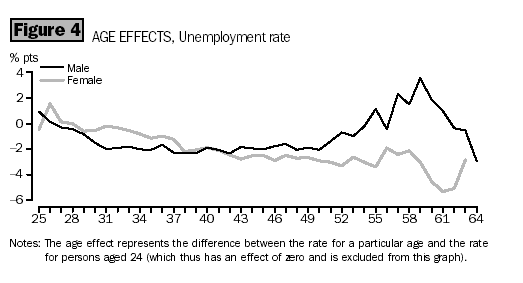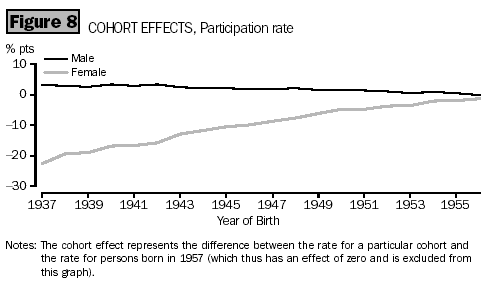|
|
LABOUR FORCE - UNEMPLOYMENT AND PARTICIPATION RATES IN AUSTRALIA: A COHORT ANALYSIS
The following article is an extract from an ABS publication, Australian Labour Market Statistics (cat. no. 6105.0) which was released on 4 July 2003. This publication draws together data from a range of sources, mostly ABS household and business surveys, to provide an overall picture of the labour market. The key purpose of this publication is to raise awareness of data availability to enable clients to use the data more effectively.
Introduction
A person's experience of the labour market will vary according to a number of factors, including the economic conditions at any given time, and their age. For example, the chance of someone finding a job decreases during a recession, while the likelihood of participating in the labour force varies as circumstances change, particularly in relation to family and education commitments. Factors affecting someone's peer group can also have a similar influence on labour market activity — people of different generations may have different expectations and experiences.
Cohort Analysis
This article presents the results of an analysis of unemployment and labour force participation rates, based on following the labour market outcomes of successive groups of individuals over time, using data from the Labour Force Survey. Twenty-one groups (birth cohorts) of people were included, with each group born in successive years between 1937 and 1957. Thus, the analysis used data for the June of each year from 1981 to 2001, including persons aged 24 to 44 in 1981, 25 to 45 in 1982, and so on, to including persons aged 44 to 64 in 2001.
The analysis (a regression-based decomposition analysis) disentangles the effects of three separate components which can influence unemployment and labour market participation — year effect, age effect and cohort effect.
Year effect
This is the effect that year had on any individual's changes of being unemployed or participating in the labour force (whatever their age). The year effect captures
movements over time that arise from the economic cycle. During periods of strong economic growth, unemployment will, in most cases, decrease for all age groups, while during economic downturns, unemployment will tend to move upwards for all age groups. Participation rates could be expected to move in the opposite direction to unemployment.
Age effect
This is the effect that a person's age had on their chances of being unemployed or participating in the labour force (whatever the year). The age effect captures movements over the life cycle. Usually younger people experience higher levels of unemployment than those in older age groups. Their level of unemployment then drops as they gain increased levels of education and work experience. It begins to rise again for ages closer to retirement age. Again, participation rates could be expected to move in the opposite direction.
Cohort effect
This is the effect that the cohort into which a person was born had on their chances of being unemployed or participating in the labour force (whatever the year and whatever their age). The cohort effect captures movements in the unemployment rate that are exclusive to that particular cohort, and will influence unemployment rates for the particular cohort over the whole period. For example, women born in the 1930s have had different labour market experiences to those born in the 1950s, throughout the economic cycle.
The following presents information on the effects of two of the components which can influence unemployment and labour market participation: age and cohort effects. For details of the third component, that is, the year effect, and more detailed analyses including the analytical method used, refer to Australian Labour Market Statistics (cat. no. 6105.0).
The Effect of Age
Unemployment
The relationship between age and unemployment, after controlling for year and cohort effects, is shown in Figure 4. Younger workers, who have only recently entered the labour market, experience higher levels of unemployment than middle aged workers, who are better established in employment. Among men, the relationship between age and unemployment remains relatively steady until their early 50s when it begins to rise, peaking at age 59. The age effects for women are considerably different, with the unemployment rate continuing to decline after age 50. Again this could be explained by women being more likely to exit the labour market than to remain unemployed. The sharp drop in unemployment rates among both men and women close to age 60 may be attributed to workers retiring from the labour market.
 
|
|
 Print Page
Print Page
 Print All
Print All